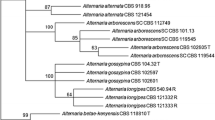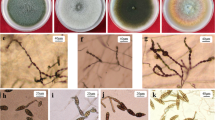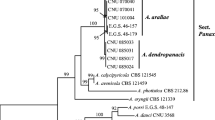Abstract
Alternaria leaf spot (ALS) of cotton, especially on cotyledons is generally considered a minor disease in Australia. However, severe disease outbreaks were recorded in multiple cotton crops in southern New South Wales (NSW) in the 2017/18 season. Due to ALS being considered a minor disease, causal species have not been formally characterised in Australia. In this study, putative small-spored Alternaria alternata was predominantly recovered from diseased cotyledons sampled from ALS hot spot fields in southern NSW as well as other locations across NSW. Species status of recovered isolates as A. alternata was confirmed through morphology and sequence analyses of the internal transcribed spacer (ITS) and translation elongation factor 1-alpha (TEF1) regions. Phylogenetic analyses of the two regions both individually or in combination resulted in a well-supported group of 69 isolates (83%) clustering with the ex-type specimen of A. alternata CBS 916.96, thus confirming the preliminary morphological identifications. In artificially inoculated assays on 15-day-old cotton seedlings, a subset of selected A. alternata isolates produced similar ALS symptoms at 7 days after inoculation (DAI) as seen in the field. Koch’s postulate was fulfilled by re-isolating A. alternata from infected ALS cotyledons at 21 DAI. This is the first main stream published report of A. alternata causing ALS on cotton cotyledons in NSW, Australia.





Similar content being viewed by others
References
Bashan Y, Levanony H, Or R (1991) Association between Alternaria macrospora and Alternaria alternata, causal agents of cotton leaf blight. Can J Bot 69:2603–2607
Bashi E, Rotem J, Pinnschmidt H, Kranz J (1983a) Influence of controlled environment and age on development of Alternaria macrospora and on shedding of leaves in cotton. Phytopathology 73:1145–1147
Bashi E, Sachs Y, Rotem J (1983b) Relationships between disease and yield in cotton fields affected by Alternaria macrospora. Phytoparasitica 11:89–98
Bhuiyan SA, Boyd MC, Martin C, Hearnden M (2007) Development of Alternaria leaf blight on north Australian cotton (Gossypium hirsutum), species prevalence, and its control using mancozeb. Australas Plant Pathol 36:488–497
Brock PM, Inwood JRB, Deverall BJ (1994) Systemic induced resistance to Alternaria macrospora in cotton (Gossypium hirsutum). Australas Plant Pathol 23:81–85
Chattannavar SN, Kulkarni S, Khadi BM (2006) Chemical control of Alternaria blight of cotton. J Cotton Res Dev 20:125–126
Cortinas MN, Crous PW, Wingfield BD, Wingfield MJ (2006) Multi-gene phylogenies and phenotypic characters distinguish two species within the Colletogloeopsis zuluensis complex associated with eucalyptus stem cankers. Stud Mycol 55:133–146
CRDC (2017) CRDC annual report 2016–2017. Cotton Research and Development Corporation
Ephrath JE, Shteinberg D, Drieshpoun J, Dinoor A, Marani A (1989) Alternaria alternata in cotton (Gossypium hirsutum) cv. Acala: effects on gas exchange, yield components and yield accumulation. Neth J Plant Pathol 95:157–166
Eveleigh R (2018) Selecting the seed. Australian cotton production manual. Cotton Research and Development Corporation, pp 36–39
Goodwin DC, Lee SB (1993) Microwave miniprep of total genomic DNA from fungi, plants, protists and animals for PCR. Biotechniques 15:438–444
Harteveld DOC, Akinsanmi OA, Drenth A (2013) Multiple Alternaria species groups are associated with leaf blotch and fruit spot diseases of apple in Australia. Plant Pathol 62:289–297
Hillocks RJ, Chinodya R (1989) The relationship between Alternaria leaf spot and potassium deficiency causing premature defoliation of cotton. Plant Pathol 38:502–508
Hosagoudar GN, Chattannavar SN, Benagi VI, Adiver SS, Patil SB, Ashtaputre AS, Patil RS (2014) Estimation of crop loss and optimization of spray schedule for Alternaria leaf spot disease in Bt cotton. Karnataka J Agric Sci 27:472–475
Kochman J, Nehl D (2000) Northern Australia contingency 1999/2000. Cotton Research and Development Corporation
Kumar S, Stecher G, Tamura K (2016) MEGA7: molecular evolutionary genetics analysis version 7.0 for bigger datasets. Mol Biol Evol 33:1870–1874
Lei T (2000) Compensation in cotton following pest damage: potential and limitations. Australian Cotton Conference, August 2000 Gold Coast, Australia. Cotton Growers Research Association
Mehta YR (1998) Severe outbreak of Stemphylium leaf blight, a new disease of cotton in Brazil. Plant Dis 82:333–336
Naranjo SE (2011) Impacts of Bt transgenic cotton on integrated pest management. J Agric Food Chem 59:5842–5851
Nayyar BG, Woodward S, Mur LAJ, Akram A, Arshad M, Saqlan Naqvi SM, Akhund S (2017) The incidence of Alternaria species associated with infected Sesamum indicum L. seeds from fields of the Punjab, Pakistan. Plant Pathol J 33:543–553
Nehl D (2007) Diseases of cotton VIII. Cotton Research and Development Corporation
Prasad BMVS, Bhattiprolu SL, Kumari PV, Kumar PA (2017) In vitro evaluation of bacterial biocontrol agents and botanicals against alternaria leaf spot caused by Alternaria macrospora in cotton. Int J Curr Microbiol App Sci 6:750–758
Rotem J, Eidt J, Wendt U, Kranz J (1988) Relative effects of Alternaria alternata and A. macrospora on cotton crops in Israel. Plant Pathol 37:16–19
Shtienberg D (1993) Effects of Alternaria macrospora on the yield components of Pima cotton in Israel. Plant Pathol 42:701–706
Shtienberg D, Dreishpoun J (1991) Suppression of Alternaria leaf spot in pima cotton by systemic fungicides. Crop Prot 10:381–385
Simmons EG (2007) Alternaria. An identification manual. CBS Biodiversity series 6. CBS Fungal Biodiversity Centre, Utrecht
Tymon LS, Peever TL, Johnson DA (2015) Identification and enumeration of small-spored Alternaria species associated with potato in the U.S. Northwest. Plant Dis 100:465–472
White T, Bruns T, Lee S, Taylor J (1990) Amplification and direct sequencing of fungal ribosomal RNA genes for phylogenetics. In: Innis M, Gelfand D, Sninsky J, White T (eds) PCR protocols: a guide to methods and applications. Academic Press, New York, pp 315–322
Woudenberg JHC, Groenewald JZ, Binder M, Crous PW (2013) Alternaria redefined. Stud Mycol 75:171–212
Acknowledgements
This research was supported through funding from the Cotton Research Development and Corporation and NSW Department of Primary Industry (projects DAN1703 and RRDP1724). We greatly thank CSIRO Agriculture and Food at Narrabri for assisting and sharing their laboratory facilities; Cotton Seed Distributors for providing cotton seeds; and CottonInfo team for sampling assistance. We specially thank Dr. Steven Simpfendorfer from NSW DPI Tamworth for critically reading and commenting for the improvement of the manuscript.
Author information
Authors and Affiliations
Corresponding author
Rights and permissions
About this article
Cite this article
Le, D.P., Gregson, A. Alternaria leaf spot of cotton seedlings grown in New South Wales, Australia is predominantly associated with Alternaria alternata. Australasian Plant Pathol. 48, 209–216 (2019). https://doi.org/10.1007/s13313-019-0617-9
Received:
Accepted:
Published:
Issue Date:
DOI: https://doi.org/10.1007/s13313-019-0617-9




